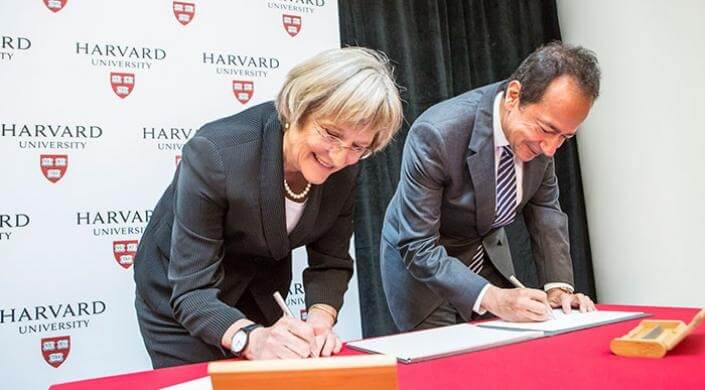News
Slideshow: A signing ceremony with John A. Paulson, M.B.A. '80, and President Drew Faust marked the celebration of Harvard's largest gift. The $400 million will support research, teaching, financial aid, and faculty development for Harvard’s School of Engineering and Applied Sciences, which has been renamed in honor of Paulson. (Photo by Eliza Grinnell/Harvard SEAS)
During the past year, SEAS faculty authored more than 800 journal articles and conference proceedings and were awarded or submitted applications for 162 patents based on their research. Below are highlights from a year of breakthrough research — as well as innovative teaching, inventive student projects, and global impact.
June 2015
John A. Paulson gives $400 million, Harvard’s largest gift ever, to endow School of Engineering and Applied Sciences. To honor his generosity, the School will be renamed the Harvard John A. Paulson School of Engineering and Applied Sciences.
Having achieved promising results in proof-of-concept prototyping and experimental testing, a soft robotic glove under development by Conor Walsh, John L. Loeb Associate Professor of Engineering and Applied Sciences, and a team of engineers at SEAS and the Wyss Institute could someday help people suffering from loss of hand motor control to regain some of their daily independence.
The ancient climate of Mars was most likely cold and icy according to a study by Robin Wordsworth, Assistant Professor in Environmental Science and Engineering, using three-dimensional atmospheric circulation models that help to explain the modern features of the planet.
Whetlab, the machine-learning startup cofounded by Ryan P. Adams, Assistant Professor of Computer Science, is acquired by Twitter. Whetlab’s technology helps automate data analysis.
A system for fluid release developed in the lab of Joanna Aizenberg, the Amy Smith Berylson Professor of Materials Science and Professor in the Department of Chemistry and Chemical Biology, could have broad-reaching impact on drug delivery systems and self-healing and anti-fouling materials. The system, self-assembled through phase separation, consists of liquid droplets inside a supramolecular polymer gel with a thin layer of liquid on its surface.
For the first time, Harvard researchers created wakes of light-like waves moving on a metallic surface, called surface plasmons, and demonstrated that they can be controlled and steered. The discovery as made in the lab of Federico Capasso, the Robert L. Wallace Professor of Applied Physics and Vinton Hayes Senior Research Fellow in Electrical Engineering.
July 2015
Combining the autonomy and speed of a rigid robot with the adaptability and resiliency of a soft robot, a team of engineers led by Robert J. Wood, Charles River Professor of Engineering and Applied Sciences, developed one of the first 3-D printed, soft robots that moves autonomously.
Harvard researchers led by Eric Mazur, the Balkanski Professor of Physics and Applied Physics and Area Dean for Applied Physics, developed a pyramid-shaped gold microstructure anchored to a flat surface that could lead to improvements in cancer treatment, drug delivery, and gene therapy. These microstructures are more stable than traditional nanoparticles.
A new microscope capable of capturing nearly 17 billion pixels in a single image was developed by researchers from SEAS and Australia. The microscope speeds up cellular imaging, making it easier to observe how cells respond to drug treatments.
Debunking conventional wisdom, Maurice Smith, the Gordon McKay Professor of Bioengineering, showed that the amount of variability associated with estimating an object’s physical dynamics, such as its weight, is the most important factor in determining grip force.
An international team of researchers including Robert Wood, Charles River Professor of Engineering and Applied Sciences at SEAS, and founder of the Harvard Microrobotics Lab, took inspiration from water strider insects to develop a novel robotic insect capable of jumping off water’s surface.
August 2015
At the Harvard Ed Portal in Allston, dozens of Boston Public School students participated in the annual “Science and Cooking for Kids” program, coordinated by SEAS and Harvard’s Public School Partnerships team. The students learned various cooking techniques and how to connect food with math and science.
A team of polymer physicists and chemists led by David A. Weitz, Mallinckrodt Professor of Physics and Applied Physics, developed a way to create an ultra-soft dry silicone rubber. This new rubber features tunable softness to match a variety of biological tissues, opening new opportunities in biomedical research and engineering.
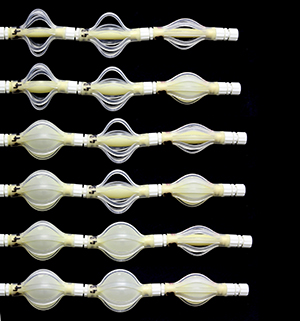 The soft actuators inflated with water. Quick movements could be triggered with small amounts of volume. For example, 1 ml. of water triggered a snap-through instability that resulted in an internal volume flow of 20 ml.
The soft actuators inflated with water. Quick movements could be triggered with small amounts of volume. For example, 1 ml. of water triggered a snap-through instability that resulted in an internal volume flow of 20 ml.
Soft machines and robots are becoming more and more functional, capable of moving, jumping, gripping an object, and even changing color. A team of researchers led by Katia Bertoldi, John L. Loeb Associate Professor of the Natural Sciences, engineered a soft actuator that harnesses the power of instability to trigger instantaneous movement.
Leveraging a biologically inspired sponge-like gel called "cryogel" as an injectable biomaterial, a team led by David Mooney, Robert P. Pinkas Family Professor of Bioengineering, developed a minimally invasive vaccine that delivers patient-specific tumor cells together with immune-stimulating biomolecules to enhance the body’s attack against cancer.
Researchers in the lab of David A. Weitz, Mallinckrodt Professor of Physics and Applied Physics, developed a system that can produce stable, amorphous nanoparticles in large quantities that dissolve quickly. The system could lead to applications in fields ranging from materials engineering to optics.
September 2015
Eli Tziperman, Pamela and Vasco McCoy, Jr. Professor of Oceanography and Applied Physics at SEAS and Department of Earth and Planetary Sciences, developed a model that explains how the increased amount of low clouds in the Arctic, due to rising Arctic temperatures, could amplify winter warming in high-latitude regions. This mechanism offers a possible explanation of both prehistoric and future continental warming in winter.
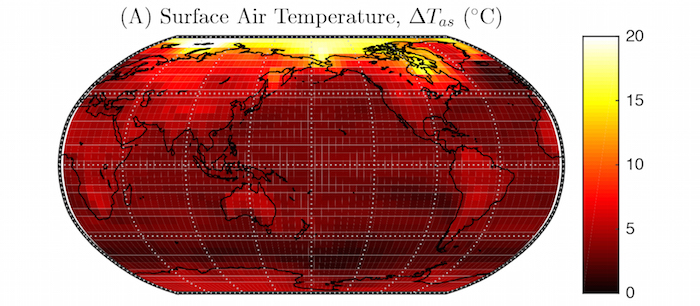
This panel shows the change in surface air temperature between a historical period from 1980-1999 to future projections from 2080-2099.
Hydroelectric energy may be more damaging to northern ecosystems than climate changeThe amount of methylmercury, a potent neurotoxin, is especially high in Arctic marine life but until recently, scientists haven’t been able to explain why. Research by Elsie Sunderland, associate professor of environmental engineering and environmental health, found that high levels of methylmercury in Arctic life are a byproduct of global warming and the melting of sea-ice in Arctic and sub-Arctic regions.
 SEAS and Harvard’s Graduate School of Design announced a new Master’s in Design Engineering (MDE) beginning in fall 2016. The two-year program will give students the skills and knowledge to take a collaborative, innovative approach to large, technically deep, complex, multi-scale, and open-ended problems. The multi-disciplinary curriculum encompasses engineering and design as well as economics, business, government regulation and policy, and sociology.
SEAS and Harvard’s Graduate School of Design announced a new Master’s in Design Engineering (MDE) beginning in fall 2016. The two-year program will give students the skills and knowledge to take a collaborative, innovative approach to large, technically deep, complex, multi-scale, and open-ended problems. The multi-disciplinary curriculum encompasses engineering and design as well as economics, business, government regulation and policy, and sociology.
Led by L. Mahadevan, Lola England de Valpine Professor of Applied Mathematics, of Organismic and Evolutionary Biology, and of Physics, a team of researchers for the first time described in detail how termite mounds are ventilated. The study revealed that the structures act similarly to a lung, inhaling and exhaling once a day as they are heated and cooled.
A team led by David Mooney, the Robert P. Pinkas Family Professor of Bioengineering, developed a strategy for embedding stem cells into porous, transplantable hydrogels that has experimentally improved bone repair by boosting the survival rate of transplanted stem cells and influencing their cell differentiation.
A parametric study by David Keith, Gordon McKay Professor of Applied Physics at SEAS and Professor of Public Policy at the Harvard Kennedy School found that the supply of wind and solar power could be increased tenfold without additional storage, poking holes in conventional wisdom.
Researchers in the lab of Jennifer A. Lewis, the Hansjörg Wyss Professor of Biologically Inspired Engineering, designed multi-material 3D printheads that mix and print concentrated viscoelastic inks that allow for the simultaneous control of composition and geometry during printing. Using active mixing and fast-switching nozzles, these novel printheads change material composition on the fly and could pave the way for entirely 3D-printed wearable devices, soft robots, and electronics.
A team of Harvard scientists and engineers led by Michael J. Aziz, Gene and Tracy Sykes Professor of Materials and Energy Technologies, Roy Gordon, Thomas Dudley Cabot Professor of Chemistry and Professor of Materials Science, demonstrated a rechargeable battery that could make storage of electricity from intermittent energy sources like solar and wind safe and cost-effective for both residential and commercial use.
October 2015
The Center for Research on Computation and Society (CRCS), launched to advance computer science research that serves the public interest, celebrated its 10-year anniversary. A symposium provided a forum for more than 100 computing experts from across the country to discuss topics at the intersection of computer science and health care, privacy, security, and government.
Researchers led by L. Mahadevan, Lola England de Valpine Professor of Applied Mathematics, of Organismic and Evolutionary Biology, and of Physics, unlocked the dynamics of evaporative patterning, revealing that the type of patterns left behind depends on the evaporation rate, particle density, fluid viscosity and surface forces between the liquid and the substrate. The findings are important because evaporation is a commonly used technique to assemble particles that are too small to manipulate individually, and to synthesize functional interfaces with unusual optical and mechanical properties.
Making Robotics Fly, an event that showcased applications for unmanned aerial vehicles organized by SEAS and the Harvard Business School, featured flight demonstrations by half a dozen drone companies. The event brought together engineers and entrepreneurs and see what the two perspectives could produce in the emerging field of drones.
In the 21st century, photonic devices, which use light to transport large amounts of information quickly, will enhance or even replace the electronic devices that are ubiquitous in our lives today. But there’s a step needed before optical connections can be integrated into telecommunications systems and computers: researchers need to make it easier to manipulate light at the nanoscale.
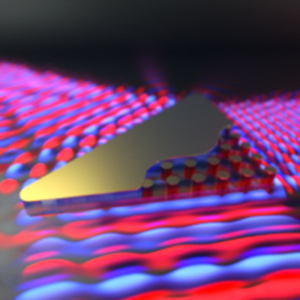 New zero-index material made of silicon pillar arrays embedded in a polymer matrix and clad in gold film creates a constant phase of light, which stretches out in infinitely long wavelengths. (Illustration by Peter Allen/Harvard SEAS)
New zero-index material made of silicon pillar arrays embedded in a polymer matrix and clad in gold film creates a constant phase of light, which stretches out in infinitely long wavelengths. (Illustration by Peter Allen/Harvard SEAS)
Researchers in the lab of Eric Mazur, the Balkanski Professor of Physics and Applied Physics, designed the first on-chip metamaterial with a refractive index of zero, meaning that the phase of light can travel infinitely fast.
Researchers in the lab of Joanna Aizenberg, Amy Smith Berylson Professor of Materials Science, demonstrated a surface coating, made from rough nanoporous tungsten oxide, that is the most durable anti-fouling and anti-corrosive material to date, capable of repelling any kind of liquid even after sustaining intense structural abuse.
Engineers demonstrated a flying, swimming, insect-like robot, paving the way for future duel aerial-aquatic robotic vehicles. The research was conducted in the lab of Robert J. Wood, Charles River Professor of Engineering and Applied Sciences. The Harvard RoboBee, designed in Wood’s lab, is a microrobot, smaller than a paperclip, that flies and hovers like an insect, flapping its tiny, nearly invisible wings 120 times per second.
Harvard launched a multidisciplinary, collaborative project to investigate climate change, energy security, and sustainable development in China with a $3.75 million grant from the Harvard Global Institute. The project will be led by atmospheric scientist Michael McElroy, Gilbert Butler Professor of Environmental Studies.
SEAS opened the first student laboratory at SEAS dedicated to microbial engineering, the newest addition to the Active Learning Labs, providing students hands-on experience in the burgeoning area of genetic engineering. The new lab enables students to conduct intricate bacterial manipulation projects.
Timely vehicle recall by German automaker Volkswagen would avoid some 130 early deaths, according to the study conducted by researchers including David Keith, Gordon McKay Professor of Applied Physics.
November 2015
Computer scientists demonstrated that they can control the sound of an object by altering its shape through computational design https://www.seas.harvard.edu/news/2015/11/change-shape-change-sound. The team, that included Hanspeter Pfister, An Wang Professor of Computer Science, created a computational optimization algorithm and used digital fabrication to control acoustic properties — both sound and vibration — by altering the shape of 2D and 3D-printed objects.
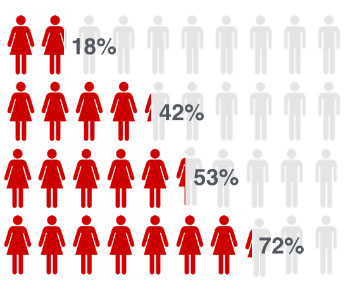 The study’s results suggest that pictograms, often ridiculed for “dumbing down” complex topics, do not negatively affect memorability and, when employed appropriately, can dramatically improve information recall. Figure by Nam Wook Kim, Harvard graduate student.
The study’s results suggest that pictograms, often ridiculed for “dumbing down” complex topics, do not negatively affect memorability and, when employed appropriately, can dramatically improve information recall. Figure by Nam Wook Kim, Harvard graduate student.
By analyzing people’s eye movements as they look at charts, graphs and infographics, Hanspeter Pfister, An Wang Professor of Computer Science, and colleagues determined which aspects of visualizations make them memorable, understandable and informative.
Yiling Chen, Gordon McKay Professor of Computer Science, was part of an international team of researchers who used prediction markets — investment platforms that reward traders for correctly predicting future events — to estimate the reproducibility of more than 40 experiments published in prominent psychology journals. The researchers found that prediction markets correctly predicted replicability in 71 percent of the cases studied.
Despite advances in surgical robotics, there is still something human hands can do better than robotic arms: feel. So far, no robotic tool can match the human hand in its ability to sense and adjust force. Research by Robert J. Wood, Charles River Professor of Engineering and Applied Sciences; and Conor Walsh, John L. Loeb Associate Professor of Engineering and Applied Sciences, demonstrated a method to build low-cost, millimeter-scale force sensors.
Researchers led by Joanna Aizenberg, Amy Smith Berylson Professor of Materials Science, deciphered how the biomineral making up the body armor of a chiton mollusk has evolved to create functional eyes embedded in the animal’s protective shell. The findings could help determine rules for generating man-made multifunctional materials that can sense physical stimuli in their environments. Early work by Aizenberg on a sea-dwelling brittlestar that uses the same mineralized material to grow both a skeleton and visual organs had set the stage for the exploration into multifunctional biomaterials.
Researchers led by David Mooney, Robert P. Pinkas Family Professor of Bioengineering, developed a more precise way to control the differentiation of stem cells into bone cells. This technique has promising applications in the realm of bone regeneration, growth and healing.
December 2015
A method developed by Vinothan Manoharan, Wagner Family Professor of Chemical Engineering and Professor of Physics, is the first step towards tracking individual proteins and genomic molecules at high speeds as they assemble to create a virus. If researchers can understand how viruses assemble, they may be able to design drugs that prevent viruses from forming in the first place.
A team of SEAS students coached by Jelani Nelson, assistant professor of computer science soundly defeated archrival MIT and dozens of universities from across the northeastern United States and Canada in the Association for Computing Machinery (ACM) International Collegiate Programming Contest. Competitors were given five hours to complete eight algorithmic problems that put their programming skills, logical abilities, and creativity to the test.
Research led by Scot Martin, Gordon McKay Professor of Environmental Chemistry, provided a clearer picture of how atmospheric particles behave. Understanding the state of the particles will determine which processes to include in models predicting climate change, enhancing the accuracy of these models.
The Arctic tundra releases at least as much methane during its cold season as it does during summer, according to a study by Steven Wofsy, Abbott Lawrence Rotch Professor of Atmospheric and Environmental Science. Relying on both ground-based and airborne measurements, the multi-institutional team of scientists observed that far more methane is escaping from Arctic tundra during the cold months when the soil surface is frozen than climate modelers previously believed.
January 2016
With support from the National Institutes of Health, researchers began one of the largest-ever long-term clinical trials of a system designed to help regulate blood sugar levels of individuals with type 1 diabetes mellitus. If successful, they could lead to commercial trials of the so-called artificial pancreas system, and eventual regulatory approval in the United States and abroad. Co-principal investigator and engineering lead on the project was Francis J. Doyle III, dean and John A. & Elizabeth S. Armstrong Professor of Engineering & Applied Sciences at SEAS.
For their team project in the hands-on course “Engineering Problem Solving and Design” (ES 96), SEAS students worked with Harvard’s Facilities Maintenance Operations organization to develop equipment to clear snow and ice from walkways and rooftops on the university’s sprawling, 5,000-acre campus. Analyzing every aspect of the process, from storm preparations, to the impact of fatigue on work crews, to the budgetary burden of keeping walkways, parking lots, and entryways passable, the students winnowed more than 100 initial ideas down to three projects: a robotic snow blower, a snow melting mat, and an icicle cutter.
Researchers led by Federico Capasso, Robert L. Wallace Professor of Applied Physics and Vinton Hayes Senior Research Fellow in Electrical Engineering, built a polarimeter on a microchip, revolutionizing the design of this widely used scientific tool that detects the direction of the oscillation of electromagnetic waves, otherwise known as the polarization of light. Having a microchip polarimeter will make polarization measurements available for the first time to a much broader range of applications, including in energy-efficient, portable devices.”
A study coauthored by Elsie Sunderland, Thomas D. Cabot Associate Professor of Environmental Science and Engineering, revealed that between 1990 and 2010, local and regional efforts had helped to reduce global mercury emissions from manmade sources by 30 percent. The results challenged long-standing assumptions about mercury emission trends.
Researchers demonstrated soft robotic grippers able to collect underwater specimens. Harvard engineer and roboticist Robert J. Wood collaborated to design, fabricate, and test soft robotic grippers for deep-sea collection of fragile biological specimens. An expedition to the Gulf of Eilat in the northern Red Sea, a unique marine ecosystem that houses one of the world’s largest and most diverse coral reefs, marked the first use of soft robotics for the non-destructive sampling of fauna from the ocean floor.
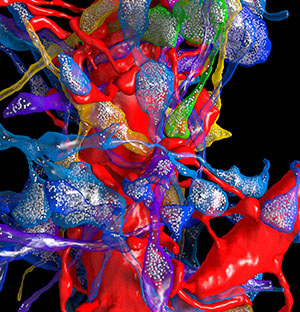 A reconstruction of cortical connectivity (Image courtesy of the Lichtman Lab/Harvard)
A reconstruction of cortical connectivity (Image courtesy of the Lichtman Lab/Harvard)
A Harvard-based “moonshot” effort was launched to develop advanced machine learning algorithms by pushing the frontiers of neuroscience. The researchers, including Hanspeter Pfister, the An Wang Professor of Computer Science; and Ryan Adams, assistant professor of computer science, will record activity in the brain's visual cortex in unprecedented detail, map its connections at a scale never before attempted, and reverse engineer the data to inspire better computer algorithms for learning.
A team led by Jennifer Lewis, Hansjörg Wyss Professor of Biologically Inspired Engineering, extended microscale 3D printing technology to the fourth dimension: time. Inspired by natural structures like plants, which change their form over time according to environmental stimuli, the team unveiled 4D-printed hydrogel composite structures that change shape upon immersion in water. The advance could lead to smart textiles, soft electronics, new biomedical devices and tissue engineering
Researchers led by David Mooney, Robert P. Pinkas Family Professor of Bioengineering, demonstrated the use of direct mechanical stimulation to repair severely damaged skeletal muscles. Mechanically-driven therapies that promote skeletal muscle regeneration through direct physical stimulation could one day replace or enhance drug and cell-based regenerative treatments.
L. Mahadevan, Lola England de Valpine Professor of Applied Mathematics, Organismic and Evolutionary Biology, and Physics, characterized a fundamental origami fold, or tessellation, that could be used as a building block to create almost any three-dimensional shape, from nanostructures to buildings. The pattern can be packed into a flat, compact shape and unfolded in one continuous motion, making it ideal for packing rigid structures like solar panels.
For the Internet of Things to fully take off, more frequency spectrum will be needed to connect the assorted devices while avoiding interference. Researchers from SEAS and Draper were awarded funding by the Defense Advanced Research Projects Agency and the U.S. Air Force Research Laboratory to develop a new approach to assembling nanoscale hardware that could enable devices to generate and receive purer signals to reduce interference with other nearby transmissions. The NanoLitz project includes Roy Gordon, Thomas Dudley Cabot Professor of Chemistry and Professor of Materials Science; Vinothan Manoharan, Wagner Family Professor of Chemical Engineering and Professor of Physics; and Michael Brenner, Glover Professor of Applied Mathematics and Applied Physics and Professor of Physics.
Researchers led by Dan Needleman, Gordon McKay Professor of Applied Physics and Professor of Molecular and Cellular Biology, observed how microtubules and motor proteins assemble into macroscopic networks. Their observation provides a better understanding of cytoskeletal self-organization in general, which may in turn lead to better drug design and new materials that can mimic cellular behaviors.
February 2016
L. Mahadevan, Lola England de Valpine Professor of Applied Mathematics, Organismic and Evolutionary Biology, and Physics, conducted a study that substantiates a simple mechanical framework for how the human brain folds. Collaborating with scientists in Finland and France, he showed that while many molecular processes are important in determining cellular events, what ultimately causes the brain to fold is a simple mechanical instability associated with buckling.
Ariel Amir, assistant professor in applied mathematics, showed that cells coordinate the replication of their DNA not through size, but by how much they grow over time. He observed the same mechanism in budding yeast cells, suggesting that this process may be prevalent across different kingdoms of life. SEAS students in the Developers for Development club collaborated with a nonprofit health agency in Peru to develop a mobile app aimed at streamlining tuberculosis treatment. Socios en Salud on the project.
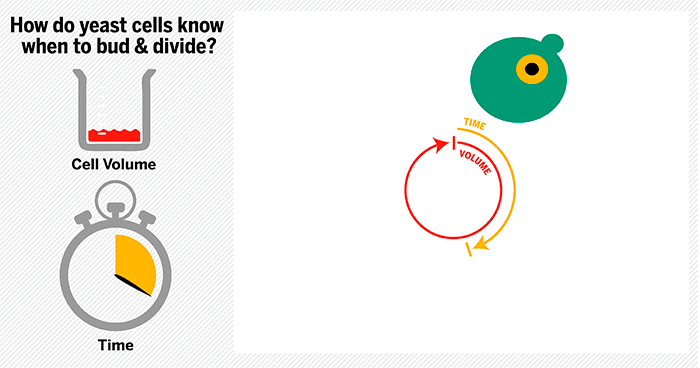
Researchers led by Philip Kim, professor of physics and applied physics, made a breakthrough in our understanding of graphene’s basic properties, observing for the first time electrons in a metal behaving like a fluid. The team improved methods to create ultra-clean graphene and developed a new way measure its thermal conductivity, research that could lead to novel thermoelectric devices as well as provide a model system to explore exotic phenomena like black holes and high-energy plasmas.
A research team led by Kit Parker, Tarr Family Professor of Bioengineering and Applied Physics, offered a new way to test heart muscle cells made from stem cells and destined for cardiac therapy. The study found that stem cell-derived cardiomyocytes have weaker contractile strength than their biological counterparts isolated from heart tissue. The findings could help explain critical shortcomings of stem cell-derived heart muscle cells in clinical trials.
Inspired by the bumpy shell of desert beetles, the asymmetric structure of cactus spines and slippery surfaces of pitcher plants, researchers led by Joanna Aizenberg, Amy Smith Berylson Professor of Materials Science, developed a better way to promote and transport condensed water droplets.
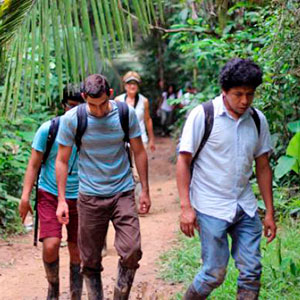 Students trek through the Amazon rainforest during a field program in Peru.
Students trek through the Amazon rainforest during a field program in Peru.
SEAS students and faculty members traveled to Amazonian rainforest of Peru’s Madre de Dios region for a two-week field program during which the students collaborated with Peruvian peers to develop equipment that could be used by local villagers to filter the contaminated water.
A SEAS student developed a mobile app-based authentication system that enables users to log in to websites using a characteristic that is impossible to forget: their fingerprint.
March 2016
A team led by Jennifer A. Lewis, the Hansörg Wyss Professor of Biologically Inspired Engineering, invented a method for 3D bioprinting thick vascularized tissue constructs composed of human stem cells, extracellular matrix, and circulatory channels lined with endothelial blood vessel cells. The resulting network of vasculature has potential for drug testing and regenerative medicine
Researchers led by Katia Bertoldi, John L. Loeb Associate Professor of the Natural Sciences, designed a new type of foldable material that is versatile, tunable and self actuated. It can change size, volume and shape; it can fold flat to withstand the weight of an elephant without breaking, and pop right back up to prepare for the next task.
Researchers led by David Clarke, Extended Tarr Family Professor of Materials, developed a technique that can quickly change the opacity of a window, turning it cloudy, clear or somewhere in between with the flick of a switch. The tunable window is comprised of a sheet of glass or plastic, sandwiched between transparent, soft elastomers sprayed with a coating of silver nanowires, too small to scatter light on their own.
A study co-authored by Peter Huybers, professor of earth and planetary sciences and of environmental science and engineering, identified sea surface temperature patterns that help predict extreme heat waves in the Eastern US up to 50 days in advance.
April 2016
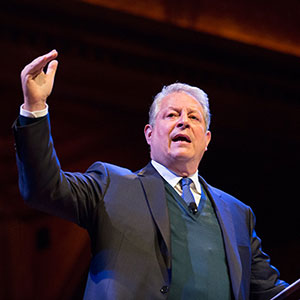 Al Gore brought a dose of optimism about climate change to Harvard, saying the problems are severe, but the solutions are emerging. The former vice president cited the adoption of renewable energy — mainly wind and solar power — as reason for hope. (Jon Chase/Harvard Staff Photographer)
Al Gore brought a dose of optimism about climate change to Harvard, saying the problems are severe, but the solutions are emerging. The former vice president cited the adoption of renewable energy — mainly wind and solar power — as reason for hope. (Jon Chase/Harvard Staff Photographer)
To help launch the SEAS-based Harvard China Project, former Vice President Al Gore spoke to a full house at 1,000-seat Sanders, bringing a dose of climate-change optimism, puncturing the typical gloom-and-doom narrative with the view that things are finally changing for the better and that the pace of that change has begun to accelerate rapidly.
Harvard received unanimous final approval from the Boston Redevelopment Authority for its planned Science and Engineering Complex in Allston. The building will house approximately two-thirds of SEAS when it opens in 2020 and will be among the most cutting-edge teaching and research facilities in the country — featuring laboratories, classrooms, and related teaching and research space.
Members of the four-year-old Harvard Undergraduate Robotics Club took home first prize in the annual mech-warfare competition at Shepherd University. During the competition, robots fire BBs at targets on enemy bots, with each hit subtracting one of a robot’s 20 hit points. Team members control their robots remotely from a different room, and only see the cityscape (and enemy robots) through a video feed from a camera on the top of their machine.
A study coauthored by Senior Research Fellow Loretta Mickley found that if emission rates continue unchecked, regions of the United States could experience between three and nine additional days per year of unhealthy ozone levels by 2050.
This increase could lead to more respiratory illness with especially dangerous consequences for children, seniors, and people suffering from asthma.
A SEAS undergrad developed a social media tool that captures the multifaceted, exploratory nature of travel. The platform provides an outlet for journey-based sharing, where people can chronicle their travels by posting photos, videos, and text .
May 2016
Researchers in the lab of Dean Frank Doyle, John A. & Elizabeth S. Armstrong Professor of Engineering & Applied Sciences, showed for the first time how neurons in the suprachiasmatic nucleus are connected to each other, shedding light on this vital area of the brain. Understanding this structure — and how it responds to disruption — is important for tackling illnesses like diabetes and posttraumatic stress disorder. The scientists have also found that disruption to these rhythms such as shifts in work schedules or blue light exposure at night can negatively impact overall health.
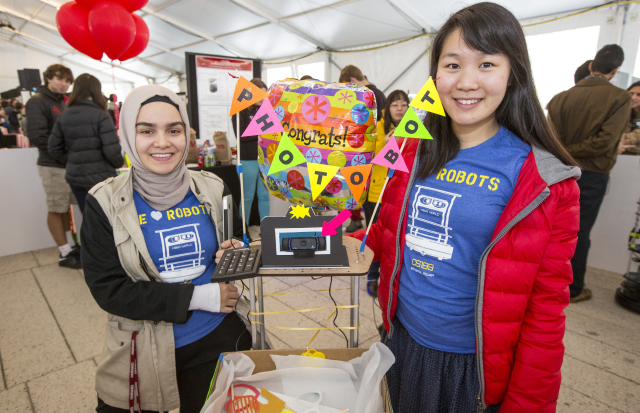
Computer science concentrators Fatma Akcay, A.B. ’16 (left) and Emily Wang, A.B. ’18, pose with their party photo robot at the SEAS Design and Project Fair. (Photo by Eliza Grinnell/SEAS Communications.)
Hundreds of students displayed their work from engineering, computer science, and applied mathematics courses at the fifth annual SEAS Design and Project Fair.
Researchers in the lab of Federico Capasso, the Robert L. Wallace Professor of Applied Physics and Vinton Hayes Senior Research Fellow in Electrical Engineering, programmed polarization into compact holograms. The holograms use nanostructures that are sensitive to polarization to produce different images depending on the polarization of incident light. The advance, which works across the spectrum of light, improves anti-fraud holograms as well as those used in
Shriram Ramanathan, Visiting Scholar in Materials Science and Mechanical Engineering, and colleagues found a way to harness the quantum behavior of fuel cells to make them more efficient and robust. In doing so, they observed a new type of phase transition in an oxide material. They discovered that by designing the electrolyte on the quantum level, they could create a material that becomes more robust when exposed to fuel.
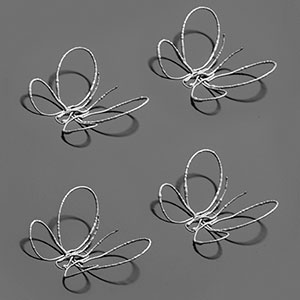 Laser-assisted direct ink writing allowed this delicate 3D butterfly to be printed without any auxiliary support structure (Image courtesy of the Lewis Lab/Harvard University)
Laser-assisted direct ink writing allowed this delicate 3D butterfly to be printed without any auxiliary support structure (Image courtesy of the Lewis Lab/Harvard University)
Increasing demand for flexible, wearable electronics, sensors, antennas and biomedical devices led Jennifer Lewis, the Hansjörg Wyss Professor of Biologically Inspired Engineering, to develop a laser-assisted direct ink writing method that allows microscopic metallic, free-standing 3D structures to be printed in one step without auxiliary support material. Lewis’ team used an ink composed of silver nanoparticles, sending it through a printing nozzle and then annealing it using a precisely programmed laser that applies just the right amount of energy to drive the ink’s solidification. The printed wires exhibit excellent electrical conductivity, almost matching that of bulk silver.
Harvard collaborated with ReWalk Robotics to develop wearable exosuits for patients with limited mobility. The agreement enables further development of soft exosuit technologies developed in the lab of Conor Walsh, John L. Loeb Associate Professor of Engineering and Applied Sciences.
Researchers led by Joanna said Aizenberg, Amy Smith Berylson Professor of Materials Science, developed a new method that can induce slipperiness on a growth supporting surface at will and sets the stage for the fast, efficient and inexpensive recovery of intact sheets of mesenchymal stem cells with broad potential for regenerative medicine.
Harvard roboticists demonstrated that their flying microrobots, nicknamed the RoboBees, can perch during flight to save energy. The RoboBee, developed in the lab of Robert Wood, Charles River Professor of Engineering and Applied Sciences, uses an electrode patch and a foam mount that absorbs shock. The entire mechanism weighs 13.4 mg, bringing the total weight of the robot to about 100mg — similar to the weight of a real bee. The robot takes off and flies normally. When the electrode patch is supplied with a charge, it can stick to almost any surface, from glass to wood to a leaf. To detach, the power supply is simply switched off.
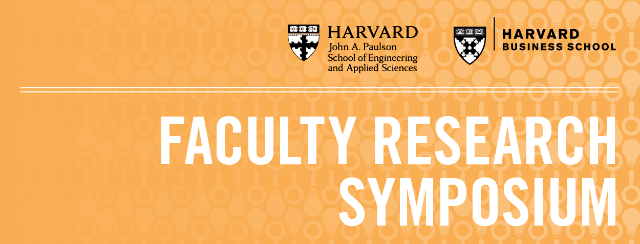
Faculty from SEAS and HBS discussed the potential for collaboration during a joint research symposium held at the business school campus in Allston.
SEAS and Harvard Business School faculty convened on the HBS campus for the first-ever joint Research Symposium, an opportunity for faculty from the two schools to highlight a variety of research findings to an audience of doctoral students, staff members, and other professors. The event was one of a series designed to explore opportunities for collaboration ahead of the expansion of the SEAS campus to a new complex across the street from the business school in a few years.
SEAS Students worked with the university’s Office for Sustainability to evaluate climate change resilience strategies as part of the course “Engineering Problem Solving and Design Project” (ES 96). They targeted three areas: enhancing the integrity of the electrical grid, cooling buildings during extreme heat, and minimizing damage from flooding.
For her senior thesis project, a computer science concentrator examined the concept of over-trusting robotic systems by conducting a human-robot interaction study on the Harvard campus. During her month-long study, she placed a wheeled robot outside several Harvard residence houses. While she controlled the machine remotely and watched its interactions unfold through a camera, the robot approached individuals and groups of students and asked to be let into the keycard-access dorm buildings.
Cutting-edge science delivered direct to your inbox.
Join the Harvard SEAS mailing list.
